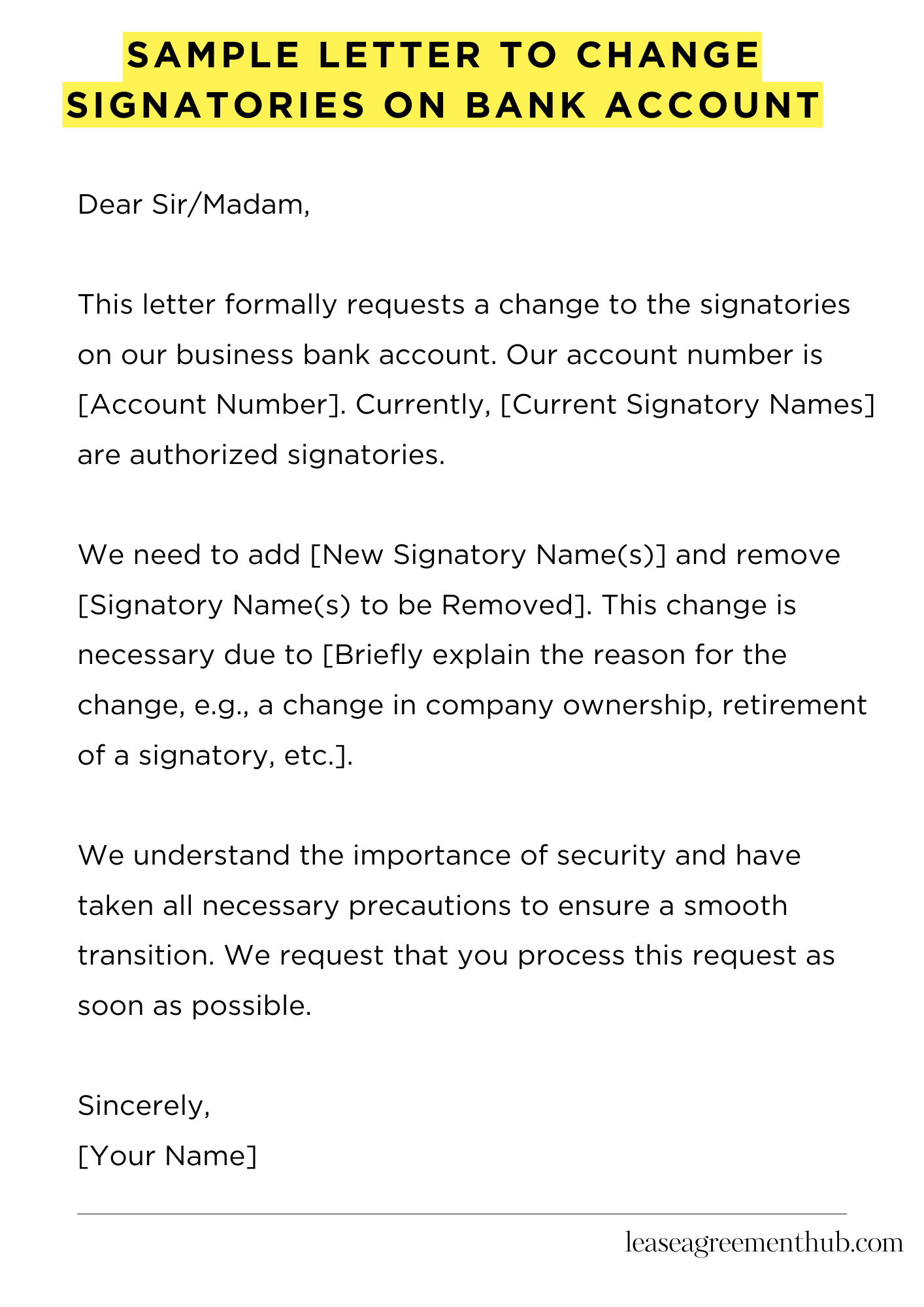Need to change who can access your bank account? A sample letter helps. It’s a formal request to your bank.
This article gives you example letters. Use them as templates. Make writing your own letter easier.
We provide various samples. Different situations are covered. Find the best fit for your needs.
Sample Letter to Change Signatories on Bank Account
[Your Name]
[Your Address]
[Your Phone Number]
[Your Email Address]
[Date]
[Bank Name]
[Bank Address]
Subject: Request to Change Signatories on Account [Account Number]
Dear Sir/Madam,
This letter formally requests a change to the signatories on our business bank account. Our account number is [Account Number]. Currently, [Current Signatory Names] are authorized signatories.
We need to add [New Signatory Name(s)] and remove [Signatory Name(s) to be Removed]. This change is necessary due to [Briefly explain the reason for the change, e.g., a change in company ownership, retirement of a signatory, etc.].
We understand the importance of security and have taken all necessary precautions to ensure a smooth transition. We request that you process this request as soon as possible.
Please confirm receipt of this letter and let us know the timeframe for processing this change. You can contact me at the number or email address provided above should you require any further information.
Thank you for your time and assistance.
Sincerely,
[Your Name]

How to Write a Sample Letter to Change Signatories on a Bank Account
Understanding the Nuances of Bank Account Signatories
Altering the signatories on a bank account is a legally significant action. It necessitates precision and a thorough understanding of your bank’s specific requirements. Failure to adhere to these stipulations can lead to complications and delays. Therefore, a meticulously crafted letter is essential.
Gathering Essential Information Before Commencing
Before embarking on the letter-writing process, ensure you possess all the necessary information. This includes the account number, the current signatories’ full names and addresses, the proposed new signatory’s complete details (including identification particulars), and the desired effective date of the change. Omitting even seemingly minor details can scuttle the entire process.
Structuring Your Letter for Clarity and Persuasiveness
Adopt a formal tone throughout your correspondence. The letter should commence with a clear and concise statement of intent: to amend the signatory list. Subsequently, provide a detailed list of existing and proposed signatories; clear identification is paramount. Conclude with a polite request for confirmation and a request for any necessary supporting documentation.
Crafting the Salutation and Body of Your Letter
Address your letter to the appropriate department, ideally the Accounts Department or a designated official. Use a formal salutation, e.g., “Dear Sir/Madam” or “To Whom It May Concern.” The body of the letter should articulate the reasons for the change—succinctly and clearly. Avoid superfluous verbiage. Maintain a professional and respectful tone throughout.
Enclosing Necessary Documentation: The Supporting Evidence
Your letter should be accompanied by supporting documentation. This might include certified copies of identification for all involved parties, or any other mandated documents as specified by your bank’s procedures. Failure to provide complete documentation will undoubtedly cause delays.
Choosing the Appropriate Delivery Method: Postal Versus Electronic
While electronic submission might seem convenient, many banks still prefer or require physical copies. Confirm your bank’s preferred method before submitting. If sending via mail, utilize registered mail for verifiable proof of delivery. This is crucial for evidentiary purposes.
Post-Submission Follow-Up: Ensuring a Timely Resolution
After submitting your letter and supporting documentation, follow up with a phone call to confirm receipt. This proactive approach showcases diligence and helps expedite the process. Maintain records of all correspondence and communication for future reference. This diligent approach minimizes potential future complications.
FAQs about sample letter to change signatories on bank account
Changing signatories on a bank account requires careful attention to detail. A well-written letter is crucial for a smooth process.
What information is essential to include in a letter to change bank account signatories?
Your letter should clearly state your request to change signatories. Include the full account name and number, the current signatory(ies), the proposed new signatory(ies) (with their full names and addresses), and the reason for the change. It’s also advisable to include your contact information.
Do I need to provide identification documents?
Yes, usually. While the letter itself outlines the change, the bank will require supporting identification documents for both the existing and new signatories to verify their identities and authorize the change. This typically includes photo identification and proof of address.
What is the best format for the letter – handwritten or typed?
A typed letter is generally preferred. Typed letters are easier to read and understand, reducing the potential for errors or misunderstandings. However, it must be signed by the authorized signatory(ies).
Where should I send the letter and supporting documents?
The letter and supporting documents should be sent to the specific bank branch where the account is held, or to the address specified by your bank for such requests. Check your bank’s website or contact them directly to confirm the correct mailing address.
What happens after I submit my letter and supporting documents?
The bank will process your request. The processing time varies depending on the bank’s policies and the complexity of the change. You’ll likely receive confirmation once the change is implemented, and you may be asked to sign a revised mandate or agreement.
Related: